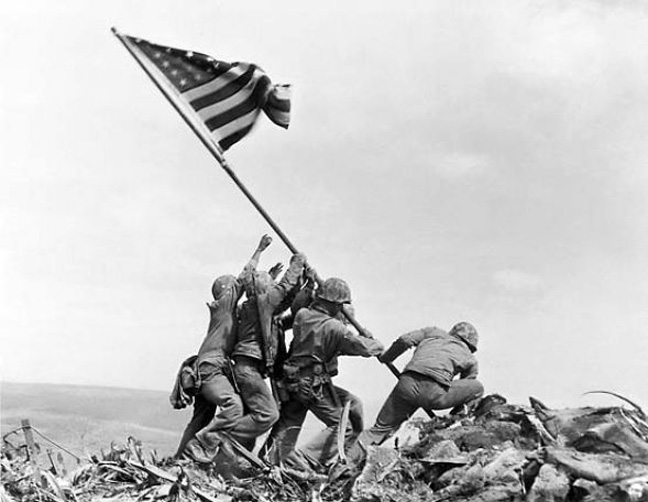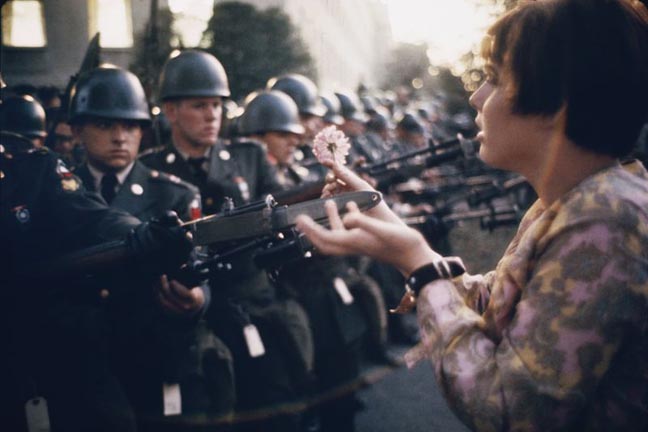 |
Diegesis: the street, four tanks, a human figure. Signifiers: the street, the four tanks, the human figure. Signified: there is a challenging nature to this photo. It can be gathered that the man opposes the mission of these tanks, which are war vehicles. It can also be ascertained, because in a battle between the two sides, the tanks would win due to strength, that the man either believes that the tanks will stop, or he is willing to die for his cause. Myth: The myth that this photo elicits is that one person can make a difference. It is clear that in a battle between four tanks and one man, the man would loose, however, with cameras watching, which in turn allowed the world to watch, the tanks were prevented from murdering the man. Another myth present in this image is that some morals are so strong in individuals that sometimes they are willing to die for what they believe in or that physical demonstrations of support or (in this case) against events must occur. |
 |
Diegesis: the human figures, the American flag, the rubble on which they are standing. Signifiers: five human figures, their clothing, the american flag, the rubble on which they are standing. Signified: The stars and stripes on the flag signifies "America." Placing a flag on land signifies victory or a territory claim or territory delineation. Because all the men are working together, it can be ascertained that all these figures are on the same side. Furthermore, because they are in uniform, it is understood that a conflict that requires armed forces has occurred and America is victorious in that conflict. The rough appearance of the land on which they are standing, signifies or connotes the fact that despite American victory, it was a hard fight and damage was caused. Myth: The myth that this photo elicits is that through teamwork and perseverance, anything is possible. Possibly a more important myth that this photograph engages with is the ideology that Americans will always come out victorious on the other side because we will do what it takes and we are strong. This photo can elicit pride in even the wariest of American citizens. |
 |
Diegesis: the woman, the flower, the guns, the men, their uniforms. Signifiers: the woman, her hand gesture, the flower, the men, their uniforms, their guns. Signified: The signified of this photograph is similar to the signified of the Tiananmen Square photograph. The flower signifies peace, while the guns signify combat. The men signify those who are in favor of combat, while the woman signifies the people who are in favor of peace. It is important to mention that women have been constructed to signify nature and the uncivilized, less heady aspects of society, while men have been constructed to signify civilization. However, this photo challenges this. Woman here is a signifier for peaceful resolution, while men have become signifiers for resolution by force. Myth: The woman digs into the myth that conflict can be resolved in peaceful ways, while the soldiers fall on the side that believes that conflict must be resolved by violence. This photograph comments on the myth that protest is a practice that can and should be engaged with. |
 |
Diegesis: the colors: red, white (technically cream), blue, the headshot, the text. Signifiers: the colors, the tilted head, the text, the man. Signified: The colors (red, white and blue) signify America or dealing with America. The colors serve to anchor the rest of the signifiers into an American context. The fact that the image of Obama is made up of these colors signifies that he is invested in America and that he is literally (in the photograph) made up of the colors that irrevocably connote America. This figuratively signifies that his self identity is invested in America's best interest. The tilt of his head signifies confidence and it is tied to the words at the bottom, which spell "hope". Hope signifies that there is a current problem that Obama can see a resolution for. His eyes are looking out to the distance, which signifies that this individual can tangibly see the hope. The tilt of his head also has Christian imagery, which posits him as a Christian in a country that currently holds Christianity as the dominant religion. Myth: The myth and ideology that is present in this image is that a strong leader is essential in a healthy democracy. Another myth present is that Obama (who is a man that signifies new, something we have not tried before, out of the ordinary formula) equals and positive potential. |
 |
 |